Class 11 - Physics
Chapter 7 - Rotational Motion
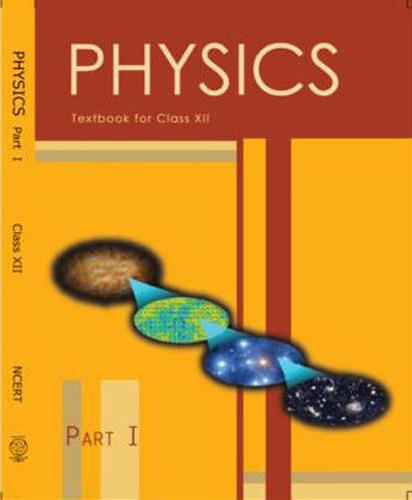
Top Block 1
Question : 1:
Give the location of the centre of mass of a (i) sphere, (ii) cylinder, (iii) ring, and (iv) cube, each of uniform mass density.
Does the centre of mass of a body necessarily lie inside the body?
Answer :
In all the cases the centre of mass is at the geometrical centre.
It is not necessary that the centre of mass will always lies inside the body.
For example: – In case of ring, a hollow sphere, and a hollow cylinder etc., the centre of mass lies outside the body.
Question : 2:
In the HCl molecule, the separation between the nuclei of the two atoms is about 1.27 Å (1 Å = 10-10 m).
Find the approximate location of the CM of the molecule, given that a chlorine atom is about 35.5 times as massive as a hydrogen atom and nearly all the mass of an atom is concentrated in its nucleus.

Given:
Distance between H and Cl atoms = 1.27Å
Mass of H atom = m
Mass of Cl atom = 35.5m
Let the centre of mass of the system lie at a distance = x from the Cl atom.
Distance of the centre of mass from the H atom = (1.27 – x)
Assuming that the centre of mass of the given molecule lies at the origin Therefore,
(m (1.27 – x) + 35.5mx)/ (m + 35.5) =0
(m (1.27 – x)) + 35.5mx =0
(1.27 – x) = -35.5x
Therefore, x = (-1.27)/ (35.5 -1)
=-0.037 Å; (-) ive sign shows that the centre of mass lies at the left of the molecule.
Hence, the centre of mass of the HCl molecule lies 0.037Å from the Cl atom.
Question : 3:
A child sits stationary at one end of a long trolley moving uniformly with a speed V on a smooth horizontal floor.
If the child gets up and runs about on the trolley in any manner, what is the speed of the CM of the (trolley + child) system?
Mddle block 1
Answer :
If the child gets up and runs about on the trolley in any manner, the speed of the centre of mass of the child and the system remains unchanged.
This happens because the forces involved are internal i.e. forces acting are within the system there is no external force acting on the system.
Question : 4:
Show that the area of the triangle contained between the vectors a and b is one half of the magnitude of a × b.
Answer :
Consider two vectors OK = |a| and OM = |b|, inclined at an angle θ, as shown in the following figure.
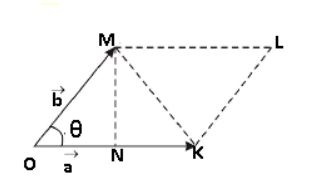
In ΔOMN,
sin θ = (MN)/ (OM)
= (MN)/ (|b|)
MN = |b| sin θ
|a x a| = |a||b| sin θ
= OK.MN x (2/2)
= 2 × Area of ΔOMK
Therefore, Area of ΔOMK = (1/2) |a x b|
Question : 5:
Show that a. (b × c) is equal in magnitude to the volume of the parallelepiped formed on the three vectors, a, b and c.
Answer :
Volume of the given parallel piped = abc
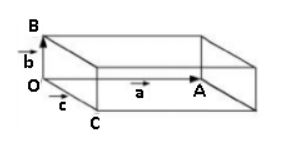
OC = a, OB = b, OC = c
Let be a unit vector perpendicular to both b and c. Hence, n and a have the same direction
Therefore, (b x c) = bc sin θ n
=bc sin 900 n
=bc n
= (a .(b x c))
=a (bc n)
=abc cos θ n
= abc cos 00
= abc
=Volume of the parallelepiped
Question : 6:
Find the components along the x, y, z axes of the angular momentum l of a particle,
whose position vector is r with components x, y, z and momentum is p with components px, py and pz.
Show that if the particle moves only in the x-y plane the angular momentum has only a z-component.
Answer :
Given:
lx = (ypz – zpy)
ly= (zpx – xpz)
lz= (xpy –ypx)
Linear momentum of the particle, p ⃗= pxî + pyĵ + pzk̂
Position vector of the particle, r ⃗= x î + yĵ + z k̂
Angular momentum, l ⃗ = (r ⃗ x p ⃗)
(x î + yĵ + z k̂) x (pxî + pyĵ + pzk̂)

lx î + lyĵ + lz k̂ = (ypz – zpy) î – (xpz – zpx) ĵ + (xpy –ypx) k̂
Comparing the coefficients of î, ĵ and k̂ we get:
lx = (ypz – zpy)
ly= (zpx – xpz)
lz= (xpy –ypx)
The particle moves in the x-y plane. Hence, the z-component of the position vector and linear momentum vector becomes zero, i.e., z = pz = 0
Thus, above equation reduces to:
lx = 0; ly = 0; lz = (xpy –ypx)
Therefore, when the particle is confined to move in the x-y plane, the direction of angular momentum is along the z-direction.
Question : 7:
Two particles, each of mass m and speed v, travel in opposite directions along parallel lines separated by a distance d.
Show that the vector angular momentum of the two particle system is the same whatever be the point about which the angular momentum is taken.
Answer :
The angular momentum of the system about point P:
Lp = (mv x 0) + (mv xd)
= mvd (i)
The angular momentum of the system about point Q:
LO = (mv x d) + (mv x 0)
=mvd (ii)
Consider a point R, which is at a distance y from point Q, i.e.
QR = y
PR = (d – y)
Angular momentum of the system about point R:
LR = (mv x (d – y)) + (mv xy)
= mvd – mvy +mvy
=mvd (iii)
Comparing equations (i), (ii) and (iii)
Lp = LO = LR … (iv)
From equation (iv) we can see that the angular momentum of a system does not depend on the point about which it is taken.
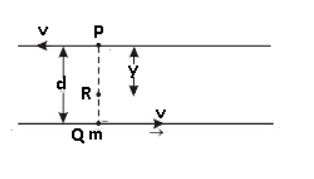
Question 8.
A non-uniform bar of weight W is suspended at rest by two strings of negligible weight as shown in Fig.7.39.
The angles made by the strings with the vertical are 36.9° and 53.1° respectively. The bar is 2 m long.
Calculate the distance d of the centre of gravity of the bar from its left end.
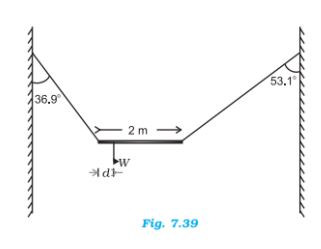
Answer :

Let:
Tension in first string = T1
Tension in second string = T2
At equilibrium, T1 sin 36.90 = T2 sin 53.10
(T1/ T2) = (sin 53.10)/ (36.90)
= (0.800)/ (0.600)
= (4/3)
=> T1 = (4/3) T2
For rotational equilibrium, on taking the torque about the centre of gravity, we have:
(T1 sin 36.90 x d) = (T2 sin 53.10(2-d)); where d= distance of the centre of gravity
(T1 x 0.800 d) = (T2 x 0.600(2-d))
(4/3) x T2 x 0.800 d = T2 [0.600 x 2 – 0.600 x d]
1.067d + 0.6d = 1.2
Therefore, d = (1.2)/ (1.67)
d =0.72m
Therefore, the C.G. (centre of gravity) of the given bar lies 0.72 m from its left end.
Question : 9:
A car weighs 1800 kg. The distance between its front and back axles is 1.8 m.
Its centre of gravity is 1.05 m behind the front axle.
Determine the force exerted by the level ground on each front wheel and each back wheel.
Answer :
Given:
Mass of the car, m = 1800 kg
Distance between the front and back axles, d = 1.8 m
Distance between the C.G. (centre of gravity) and the back axle = 1.05 m
The various forces acting on the car are shown in the following figure.
Rf and Rb are the forces exerted by the level ground on the front and back wheels respectively.
At translational equilibrium:
(Rf + Rb)= mg
= (1800 × 9.8)
= 17640 N … (i)
For rotational equilibrium, on taking the torque about the C.G., we have:
Rf (1.05) = Rb (1.8 – 1.05)
(Rf x 1.05) = (Rb x 0.75)
(Rf / Rb) = (0.75)/ (1.05)
(Rf / Rb) = (5/7)
(Rb / Rf) = (7/5)
Rb = (1.4) Rf (ii)
Solving equations (i) and (ii), we get:
(1.4) Rf + Rf = 17640
Rf = (17640/2.4)
=7350N
Therefore, Rb = (17640 – 7350)
= 10290 N
Therefore, the force exerted on each front wheel, (7350)/ (2) = 3675N
The force exerted on each back wheel, (10290)/ (2) = 5145N
Question : 10:
(a) Find the moment of inertia of a sphere about a tangent to the sphere, given the moment of inertia of the sphere about any of its diameters to be 2MR2/5,
where M is the mass of the sphere and R is the radius of the sphere.
(b) Given the moment of inertia of a disc of mass M and radius R about any of its diameters to be MR2/4,
find its moment of inertia about an axis normal to the disc and passing through a point on its edge.
Answer :
- Given:
Moment of inertia of a sphere about its diameter = (2/5) MR2
Mass of the disc= M
Radius of the disc= R
Using theorem of parallel axes,
Moment of inertia of sphere about a tangent to sphere
= (2/5) MR2 + M (R2)
= (7/5) MR2

- The moment of inertia of a disc about its diameter=(1/4) MR2
Applying theorem of perpendicular axes, the moment of inertia of the disc about an axis passing through its centre and normal to its disc
= (1/4) MR2) + (1/4) MR2)
= (1/2) MR2
Again applying the theorem of parallel axis, the moment of inertia of the disc passing through a point on its edge and normal to the disc is:
I = (1/2) MR2 + (MR2)
= (3/2) MR2

Question : 11:
Torques of equal magnitude is applied to a hollow cylinder and a solid sphere, both having the same mass and radius.
The cylinder is free to rotate about its standard axis of symmetry, and the sphere is free to rotate about an axis passing through its centre.
Which of the two will acquire a greater angular speed after a given time?
Answer :
Moment of inertia of a cylinder about its axis of symmetry Ic = MR2
Moment of inertia of a sphere about its diameter Is = (2/5) MR2
Angular acceleration α = (τ /I)
αc =( τ /Is)
= (τ / (2/5) MR2
= (2.5) = (τ /MR2)
=2.5 αc
The sphere will acquire a greatest angular acceleration.
Question 12 :
A solid cylinder of mass 20 kg rotates about its axis with angular speed 100 rad s-1.
The radius of the cylinder is 0.25 m. What is the kinetic energy associated with the rotation of the cylinder?
What is the magnitude of angular momentum of the cylinder about its axis?
Answer :
Given:
Mass of the cylinder, m = 20 kg
Angular speed, ω = 100 rad
Radius of the cylinder, r = 0.25 m
The moment of inertia of the solid cylinder:
I = (mr2)/ (2)
= (1/2) x 20 x (0.25)2
=0.625kgm2
Therefore, Kinetic energy = (1/2) I ω2
= (1/2) x 6.25 x (100)2
=3125J
Therefore, Angular momentum L = I ω
= (6.25 x 100)
=62.5J
Question 13 :
(a) A child stands at the centre of a turntable with his two arms outstretched.
The turntable is set rotating with an angular speed of 40 rev/min How much is the angular speed of the child if he folds
his hands back and thereby reduces his moment of inertia to 2/5 times the initial value? Assume that the turntable rotates without friction.
(b) Show that the child’s new kinetic energy of rotation is more than the initial kinetic energy of rotation. How do you account for this increase in kinetic energy?
Answer :
- Let:
Initial moment of inertia = I1
Final moment of inertia = I2
Initial angular speed, ω1 = 40 rev/min
Final angular speed = ω2
According to principle of conservation of angular momentum
I1 ω1 = I2 ω2
ω2 = (I1/ I2) ω1
= (I1)/ ((2/5) I2) x 40
= (5/2) x 40
= (100) rev/min
- Initial kinetic energy of rotation , E1 =(1/2) I1 ω12
Final kinetic energy of rotation, E2 = (1/2) I2 ω22
Therefore,
= (E2/ E1) = (1/2) I2 ω22/ (1/2) I1 ω12
= (I2/ I1) (ω2/ ω1)2
= ((2/5) I1/I1) (100/40)2
(E2/ E1) = 2.5
Or E2 = 2.5 E1
Question 14 :
A rope of negligible mass is wound round a hollow cylinder of mass 3 kg and radius 40 cm.
What is the angular acceleration of the cylinder if the rope is pulled with a force of 30 N? What is the linear acceleration of the rope? Assume that there is no slipping.
Answer :
Given:
Mass of the hollow cylinder, m = 3 kg
Radius of the hollow cylinder, r = 40 cm = 0.4 m
Applied force, F = 30 N
The torque acting on the cylinder,
τ = force x radius of cylinder
=30 N x 0.4m
=12Nm
The moment of inertia of the hollow cylinder about its geometric axis:
I = mr
= 3 × (0.4)2
Therefore, I = 0.48 kg m2
For angular acceleration α, produced in the cylinder is:
τ =I α
α = (12/0.48)
=25rad/sec2
Therefore, Linear acceleration of the rope,
a= (R α)
a=0.4 x 25 ms-2
=10ms-2
Question 15 :
To maintain a rotor at a uniform angular speed or 200 rad s-1, an engine needs to transmit a torque of 180 N m.
What is the power required by the engine?
(Note: uniform angular velocity in the absence of friction implies zero torque. In practice, applied torque is needed to counter frictional torque). Assume that the engine is 100% efficient.
Answer :
Given:
Angular speed of the rotor, ω = 200 rad/s
Torque required, τ = 180 Nm
Using, P = τ ω
= (180 × 200)
= 36 × 103
= 36 kW
Hence, the power required by the engine is 36 kW.
Question 16 :
From a uniform disk of radius R, a circular hole of radius R/2 is cut out. The centre of the hole is at R/2 from the centre of the original disc.
Locate the centre of gravity of the resulting flat body.
Answer :
Mass per unit area of the original disc = σ
Radius of the original disc = R
Mass of the original disc, M = (πR2σ)
The disc with the cut portion is shown in the following figure:

Radius of the smaller disc = (R/2)
Mass of the smaller disc, M’= π(R/2)2 σ
= (1/4) π R2 σ
= (M/4)
Let O and O’ be the respective centres of the original disc and the disc cut off from the original.
By the definition of the centre of mass, the centre of mass of the original disc is supposed to be concentrated at O,
while that of the smaller disc is supposed to be concentrated at O’.
It is given that:
OO’ = (R/2)
After the smaller disc has been cut from the original, the remaining portion is considered to be a system of two masses. The two masses are:
M (concentrated at O), and
-M’ (M/4) concentrated at O’; where (-) ive sign shows that this is the portion removed from the original disc.
Let the distance through which the centre of mass of the remaining portion shifts from point O = x
The relation between the centres of masses of two masses is given as:
x = (m1r1+m2r2)/ (m1+m2)
For the given system,
x = ((Mx0)-M’ (R/2))/ (M + (-M’))
= ((-M/4) x (R/2))/ (M – (M/4))
= (-MR)/8 x (4/3M)
= (-R/6); where (-) ive sign indicates that the centre of mass gets shifted toward the left of point O
Question 17 :
A metre stick is balanced on a knife edge at its centre.
When two coins, each of mass 5 g are put one on top of the other at the 12.0 cm mark, the stick is found to be balanced at 45.0 cm. What is the mass of the metre stick?
Answer :
The mass of the metre stick is concentrated at its mid-point, i.e., at the 50 cm mark.
Mass of the meter stick = M’
Mass of each coin, m = 5 g
When the coins are placed 12 cm away from the end P, the centre of mass gets shifted by 5 cm from point R toward the end P.

The centre of mass is located at a distance of 45 cm from point P.
The net torque will be conserved for rotational equilibrium about point R.
10 x g (45 -12) –M’g (50-40) =0
Therefore, M’ = (10 x33)/ (5)
=66g
Hence, the mass of the metre stick is 66 g.
Question 18 :
A solid sphere rolls down two different inclined planes of the same heights but different angles of inclination.
(a) Will it reach the bottom with the same speed in each case? (b) Will it take longer to roll down one plane than the other? (c) If so, which one and why?
Answer :
- Yes it will reach the bottom with same height.
Given:
Mass of the sphere = m
Height of the plane = h
Velocity of the sphere at the bottom of the plane = v
At the top of the plane, the total energy of the sphere = Potential energy = mgh
At the bottom of the plane, the sphere has both translational and rotational kinetic energies.
Hence, total energy = (1/2) mv2 + (1/2) Iω2
Using the law of conservation of energy, we can write:
(1/2) mv2 + (1/2) Iω2 = mgh (i)
For a solid sphere, the moment of inertia about its centre, I = (2/5) mr2
Hence, equation (i) becomes:
(1/2) mv2 + (1/2) ((2/5) (mr2)) ω2 = mgh
(1/2) mv2 + (1/5) r2 ω2 =gh
Using the relation, v= r ω
Therefore (1/2) v2 + (1/5) v2 =gh
v2 (7/10) = gh
v =√ (10/7)gh
Since height (h) is same for both inclined planes, the sphere will reach the bottom with the same speed.
- As the height is the same, the time taken to reach the bottom will be the same in both the cases.
For both (b) and (c)
As θ1 < θ2; where θ1 and θ2 are the inclinations of the two inclined planes
The acceleration produced in the sphere when it rolls down the plane inclined at θ1 = g sin θ1
The various forces acting on the sphere are shown in the following figure.

R1 is the normal reaction to the sphere.
Similarly, the acceleration produced in the sphere when it rolls down the plane inclined at θ2 = g sin θ2
The various forces acting on the sphere are shown in the following figure.
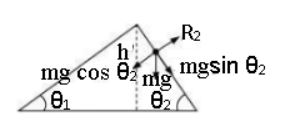
R2 is the normal reaction to the sphere.
θ2 > θ1; sin θ2 > sin θ1 … (i)
Therefore, a2 > a1 … (ii)
Initial velocity, u = 0
Final velocity, v = Constant
From the first equation of motion,
v = u + at
=> t ∝ (1/a)
For inclination θ1: t1 (1/a1)
For inclination θ2:t2 (1/a2)
From equations (ii) and (iii), we get:
t2 < t1
Hence, the sphere will take a longer time to reach the bottom of the inclined plane having the smaller inclination.
Question 19.
A hoop of radius 2 m weighs 100 kg. It rolls along a horizontal floor so that its centre of mass has a speed of 20 cm/s. How much work has to be done to stop it?
Answer :
Given:
Radius of the hoop, r = 2 m
Mass of the hoop, m = 100 kg
Velocity of the hoop, v = 20 cm/s = 0.2 m/s
Work required to stop the hoop = Total energy possessed by the loop
Therefore W = (1/2) M v2 + (1/2) (MR2) (v2/R2)
= Mv2
W = 100 x (0.2)2
W = 4J
Bottom Block 3
Click here to visit Official CBSE website
Click here for NCERT solutions
Click here to visit Official Website of NCERT
Click here to download NCERT Textbooks
